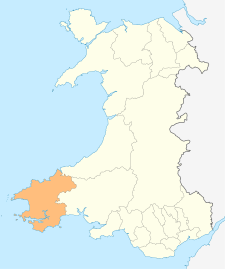Boncath
Boncath is a village, community and postal district in north Pembrokeshire, Wales, about 5 miles (8.0 km) west of Newcastle Emlyn.
| Boncath | |
|---|---|
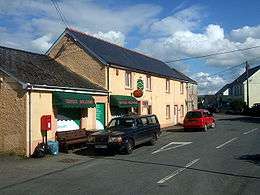 Boncath Post Office and shop | |
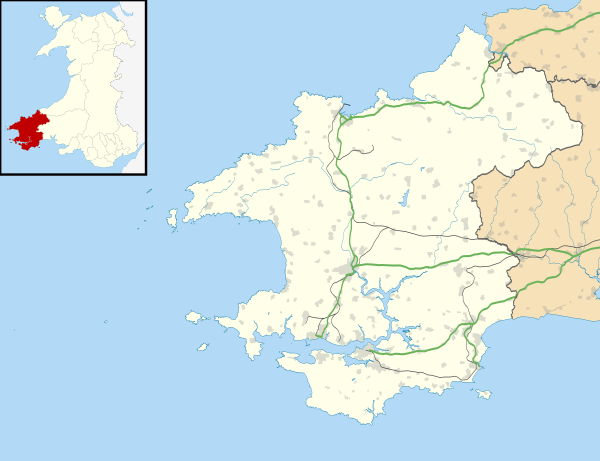 Boncath Location within Pembrokeshire | |
| Population | 736 (2011)[1] |
| OS grid reference | SN2038 |
| Principal area | |
| Country | Wales |
| Sovereign state | United Kingdom |
| Post town | Boncath |
| Postcode district | SA37 |
| Dialling code | 01239 |
| Police | Dyfed-Powys |
| Fire | Mid and West Wales |
| Ambulance | Welsh |
| UK Parliament | |
The village stands at a cross-roads linking the nearby settlements of Newchapel (Capelnewydd), Eglwyswrw, Blaenffos and Bwlchygroes. Formerly a hamlet around an inn, the village developed after the coming of the railway in 1885.
History
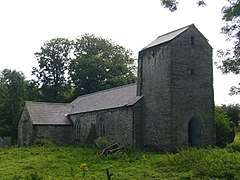
The name of the village comes from the Welsh word for buzzard, bwncath. It was recorded on a pre-1850 historical parish map as in the parish of Llanfihangel Penbedw (St Michael)[2] in the Hundred of Cilgerran.[3] Llanfihangel Penbedw parish church, which dates from 1325 or earlier, was restored in 1859 but fell into disuse in the 1970s.[4] Part of the village lies in Capel Colman parish.
The Boncath Inn (formerly Tavern) has stood at the crossroads at least since 1862 when Thomas Rees, publican, farmer, and grocer, was listed as bankrupt in October 1862[5] and discharged in the December.[6] Despite the coming of the railway, in 1890 David George of Boncath Tavern, innkeeper and farmer, was reported as receiving an order and adjudication in bankruptcy.[7] In June he was subjected to public examination in Carmarthen.[8] In August, the dividend payable to creditors was fixed at 4s 10½d to the pound (£), or about 24 per cent, payable in September.[9]
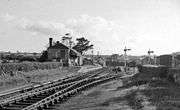
Boncath developed into a larger settlement when the Whitland and Taf Vale Railway was extended to Cardigan in 1885.[10] Boncath railway station, opened in September 1886, was a two-platform stop between Crymmych Arms and Kilgerran Halt on the Whitland and Cardigan Railway, known as "Cardi Bach". The line was closed due to the 1963 Beeching Axe and the station building became a private residence.[11]
The village once included three tailors, a cobbler and a dressmaker, and in 2000 a new Community Hall was completed.[12]
There are 27 listed structures in the community,[13] 19 of which are associated with Cilwendeg House,[14] described as one of the most important mansions in Pembrokeshire. Cilwendeg dates from the late 18th century and was built on the site of a former property dating back to the 1600s. One of the features of the property is the Grade II* listed Shell House[15] built in the late 1820s. Many other structures on the property are listed.[16] The 21 bedroom mansion was a care home from 1952 to 2010.[17] Cilwendeg hosted the 2013 Urdd National Eisteddfod.[18]
Amenities
The Boncath Inn (now closed) stands in the centre of the village along with a village shop/Post Office and a number of small businesses. Bus service 430 passes through the village, running between Cardigan and Narberth.
The Welsh Independent Chapel at Fachendre (Fach-hendre), established in 1879, is to the south-east of the village and is a historic monument.[19]
The Community Hall, a registered charity, provides a venue for events in the local area.[12]
Administration
The village has its own elected community council and is part of the Clydau electoral ward for the purposes of elections to Pembrokeshire County Council. The civic community is split into two electoral wards: Llanfihangel, consisting of the former parishes of Castellan (including the village of Blaenffos) and Llanfihangel Penbedw, and Capel Colman, consisting of the parishes of Capel Colman and Penrydd.[20]
References
- "Community population 2011". Retrieved 17 April 2015.
- Kain, R.J.P.; Oliver, R.R. (2001). Historic Parishes of England and Wales. History Data Service. Retrieved 7 June 2014.
- "GENUKI - Cilgerran Hundred". Retrieved 7 June 2014.
- "The derelict Miscellany - St Michael's Parish Church". Retrieved 8 June 2014.
- "Bankrupts in The Country". Perry's Bankrupt Gazette. British Newspaper Archive. 25 October 1862. Retrieved 19 July 2014.
- "Bristol Bankruptcy Court". Western Daily Press. British Newspaper Archive. 10 December 1862. Retrieved 18 July 2014.
- "Gazette". Western Daily Press. British Newspaper Archive. 21 May 1890. Retrieved 18 July 2014.
- "First meetings and dates of public examinations". Liverpool Mercury. British Newspaper Archive. 26 May 1890. Retrieved 18 July 2014.
- "London Gazette - Bankrupts". Birmingham Daily Post. British Newspaper Archive. 27 August 1890. Retrieved 18 July 2014.
- Hughes, B.H.J. Pembrokeshire Historical Gazetteer. Internet Archive. Retrieved 20 November 2013.
- "Disused stations: Boncath". Retrieved 1 January 2014.
- "Pembrokeshire Community Halls: Boncath". Archived from the original on 12 August 2013. Retrieved 1 January 2014.
- "British Listed Buildings: Boncath". Retrieved 9 February 2020.
- Cadw. "Cilwendeg (Grade II) (13020)". National Historic Assets of Wales. Retrieved 9 February 2020.
- Cadw. "The Shell House (Grade II*) (13025)". National Historic Assets of Wales. Retrieved 21 July 2019.
- "British Listed Buildings: Cilwendeg". Retrieved 21 July 2019.
- "Cilwendeg House up for sale". Wales Online. 6 March 2012. Archived from the original on 13 May 2014. Retrieved 1 July 2014.
- "Urdd National Eisteddfod". Retrieved 1 July 2014.
- "Royal Commission on the Ancient and Historical Monuments of Wales - Fachendre Chapel". Retrieved 8 June 2014.
- Pembrokeshire County Council: Review of Communities. Pembrokeshire County Council. 2007.
External links
| Wikimedia Commons has media related to Boncath. |
| Preceding station | Historical railways | Following station | ||
|---|---|---|---|---|
| Crymych | Great Western Railway Whitland & Cardigan Railway |
Cilgerran | ||
